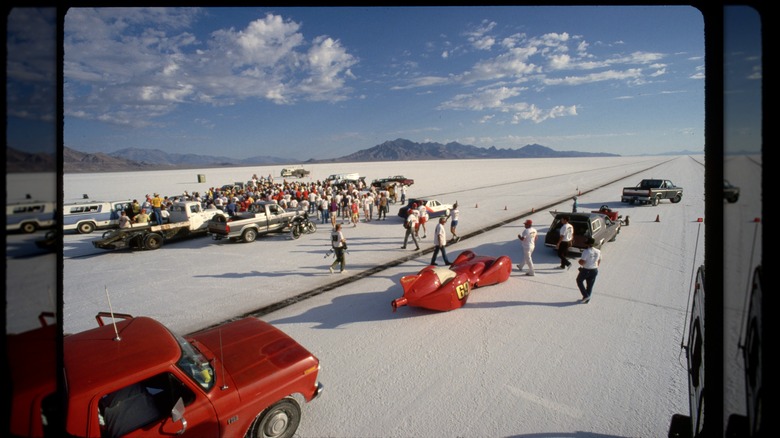If you’ve ever driven along I-80 between Wendover, a small stopover town that sits on the very western edge of Nevada, and Salt Lake City in Utah, then you’ve driven across the Great Salt Lake. Not only is it the largest saltwater lake in the Western Hemisphere, but it’s also one of the most saline lakes in the world. This defining feature — approximately 90% of which is common table salt — is the reason why the Bonneville Speedway is home to so many top speed records.
The Bonneville Salt Flats covers some 30,000 acres on the western edge of the Great Salt Lake basin in Utah. The 12-mile-long by 5-mile-wide (about 46 square miles) expanse consists of a salt crust whose thickness can range from as little as a few inches to as much as five feet. The rains that come during the winter months cause the salt crust to bake in the hot summer months and turn it into a completely flat surface as hard as concrete, making the area an ideal location for racing. Racers first came to the Salt Flats in 1912, and it’s home to the craziest race you may have never heard of.
In 1935, Sir Malcolm Campbell became the first man to break the 300-mph threshold, reaching 301.331mph in a specially built car called “Bluebird.” The last outright record set at Bonneville was in 1970, when Gary Gabelich, driving a rocket-powered vehicle called the “Blue Flame,” became the first person to exceed the 600-mph mark (at 630.478 mph).
Blinding white salt as far as the eye can see
Lake Bonneville once covered a third of the area we know as the state of Utah, with the current location of the Salt Flats under nearly 1,000 feet of water at the time. All that freshwater began to disappear at the end of the last Ice Age, and the water left minerals such as gypsum (found in drywall), halite (table salt), potassium, and magnesium in its wake. It’s estimated that as much as 147 million tons of salt cover the area.
The U.S. government owns most of the Bonneville Salt Flats, and the area is littered with storage depots, testing areas, and bombing ranges. In fact, the team involved with the atom bomb in 1945 actually trained on the Salt Flats. The environment can be deadly, too: The water that remains in the lake today is so corrosive it’s capable of damaging a vehicle’s electrical system and causing it to short out.
While Bonneville still hosts three annual speed events a year (for a laundry list of vehicle classes), it’s no longer the pinnacle of speed. Why? It simply wasn’t big enough. As speeds crept towards the supersonic threshold, Black Rock Desert in Nevada became the place to go. That’s where the reigning world record was set, when Andy Green broke the sound barrier in the Thrust SSC, hitting 763.035 mph (Mach 1.02) in 1994. He covered one mile in just under 4.7 seconds but needed six miles to reach top speed and another six to stop. For safety reasons, though, an additional 20 miles was necessary in case the parachute failed, which was more than Bonneville could provide.

